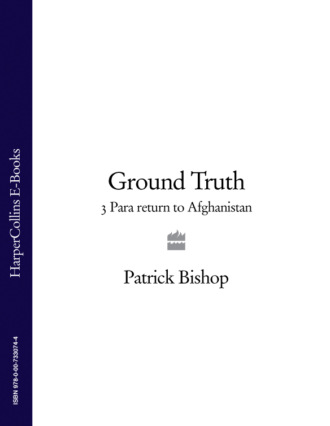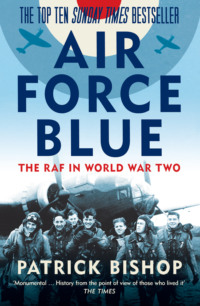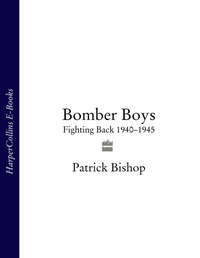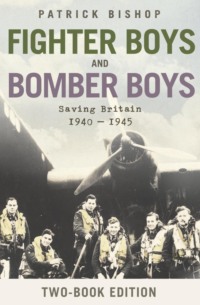
Полная версия
Ground Truth: 3 Para Return to Afghanistan
The exhanges went on intermittently for the rest of the morning, settling into a sort of routine in which each hopeful prod by the Taliban rocket-propelled grenades (RPGs) and machine guns was met by a great retaliatory thump from the British mortars and artillery. The silence rolled in quickly to fill the spaces between the explosions. In the middle of the quiet, from high overhead, another sound drifted down, distant and familiar. Miles above, a faint white line was crawling eastwards across the cloudless sky. There were no high-flying bombers on station. The condensation trail came from an airliner, one of the dozens that pass to and fro every day and night, carrying tourists and business people from London and Paris and Rome to Delhi and Singapore and Sydney. It was noon now. The trolleys would be passing along the aisle while the cabin crew offered passengers the choice of beef or chicken. Perhaps, eight kilometres up, someone was looking out of the window at the pinprick flashes and scraps of smoke and wondering what was going on. Down below, in a medieval landscape of mud houses and dirt roads, the violence was petering out. For ten minutes there was no shooting from the Taliban. 3 Para’s Regimental Sergeant Major Morgan ‘Moggy’ Bridge had decided it was a good time to head back down the mountain. Stu Hale took the lead, bounding over the first boulders. The distant drone of the airliner faded away. The only sound was our breathing. It seemed to be all over. Then, after 100 metres, we heard behind us the throb of the Sparrow Hawk .50-cal machine gun opening up and the sound of violence rolled once more over the harsh and beautiful landscape.
2 Through the Looking Glass
On the morning of Monday 3 March 2008, a cold, blustery day on which spring seemed far away, the headquarters party of the Third Battalion of the Parachute Regiment arrived at Brize Norton airbase to await the RAF flight that would take them to Kandahar and a new Afghan adventure. The departure lounge was crowded with men and women from all branches of the British services. They sat hunched in what little pockets of privacy they could find, making a last call on their mobiles or stretched out on the carpet catching up on sleep. Brize was where they passed through the looking glass. On one side lay the muddy pastures and bare trees of Oxfordshire. On the other, the mountains, deserts and poppy fields of Helmand. The physical journey was nothing compared to the psychological distance they were about to travel. Here there was security and comfort. Beyond lay a realm of fear, danger and hardship.
Many of the Paras who flew out during the following days had taken part in the great events of the summer of 2006. In the eighteen months they had been away, though, much had changed. The 3 Para Battlegroup had written the opening chapter of Britain’s latest Afghan war. But the plot had moved on and the shape of the action had altered. The battalion looked different too. The Paras had a new colonel and a changed cast of characters. Four out of ten of the veterans of the last tour had left, having quit the army or transferred to other units. They also had a new role that would require skills other than the sheer fighting ability that had sustained them last time.
The battalion was now led by Huw Williams, a lean, relaxed Welshman. He inherited a unit that was still preoccupied with its recent history. The 2006 tour had already entered military folklore, and if some of the prominent original players had departed, their ghosts still lingered on.
Williams had taken over from Stuart Tootal, a complex figure who had sublimated himself in the drama of the campaign, reacting emotionally to its triumphs, crises and setbacks and taking each death and injury as a personal tragedy. His demanding personality had made him a few enemies among his senior officers. There were many more, though, who admired and respected him.
Tootal’s two-year command period ended in November 2007. Early in 2008 he announced he was leaving the army. The news came as a surprise. His bosses thought highly of him and he was assumed to be on a rising path that could take him to the upper reaches of of the army. Tootal was close to several influential journalists. He used his departure to publicise what he said were serious failings in the way the government equipped the men they sent to war and the shameful treatment the wounded received when they returned home. Out of uniform he continued to speak out as a part-time media commentator, which he combined with a top job at Barclays Bank.
To some, his decision to leave was easy to understand. Nothing could ever match the prestige of commanding an elite unit like 3 Para on the most intense operation it had faced since the Falk-lands War. Tootal told friends that if he had continued his army career, subsequent postings were unlikely to come close to matching the excitement and satisfaction he found in Helmand, no matter how far up the ladder he climbed.
Tootal was still commanding 3 Para when it was announced that the battalion would be returning to Afghanistan in the spring of 2008 for Operation Herrick 8. The Paras would be playing a multiple role. Their main function was to act as the rapid reaction force for the NATO commander of southern Afghanistan, going wherever he thought they were needed. But they were also expected to work with 16 Air Assault Brigade, their parent formation, which was deploying at the same time in Helmand.
During early planning meetings for Herrick 8, the brigade got used to the battalion harking back to the experiences in Herrick 4. ‘There was a feeling in 16 Brigade that…3 Para were a backward-looking organisation who only wanted to talk about Herrick 4 and didn’t want to look forward,’ said an officer. ‘Everything [the Brigade] tried to do or talk about was greeted with “well, on Herrick 4 it was like this” and “of course, you don’t understand what it’s like”. The battalion wasn’t overly popular and there was a feeling that they were pulling in a different direction.’
Huw Williams knew as much as anyone about Herrick 4. He had been 3 Para’s second-in-command during the tour, carrying the unglamorous responsibility of keeping the battalion machine running while the colonel got on with the exhausting but exhilarating job of command. But he felt it was time to let the experience go. He was determined that the shadows cast by the legends of 2006 would not obscure the new tasks and changed circumstances facing him and his men. After taking over in November 2007 he told his men that Herrick 4 belonged to the glorious past. Everyone was to look ahead and prepare for a different situation and different role.
The British Army had gone to Helmand in 2006 with only the sketchiest plan, which had been erased by the first contact with reality. They had been sent to a place which most soldiers regarded as being of only peripheral strategic importance. Once there, they were soon stuck with it, enmeshed in a process whose direction they were unable to control. 3 Para Battlegroup was supposed to create a climate of stability in a small area around Helmand’s provincial capital, Lashkar Gah, in which development and reconstruction work could begin. Instead they found themselves riding to the rescue of the Afghan government whose thinly spread forces were under attack from the Taliban. Their area of operations expanded out of the original triangle bounded by Lashkar Gah, the town of Gereshk and the Camp Bastion logistics base to the northern settlements of Sangin, Musa Qaleh and Now Zad.
In the process they became the main targets of the Taliban and sank into an intense attritional slog that lasted throughout the summer. The conflict was later presented officially as the ‘break in battle’, the fighting that has to be done to establish a force in-theatre. But the term was a post facto justification and no such exercise had been envisaged when the soldiers set out. The break in battle decided nothing. The Paras, in the judgement of one of their senior officers, were intent on ‘just surviving’. It was exhaustion which eventually brought the fighting to a close, and the welcome onset of winter.
When spring came the Taliban re-emerged to face a new British force. The Paras had been succeeded by 3 Commando Brigade. They were relieved in turn six months later by 12 Mechanised Brigade. Then in October 2007 their place was taken by 52 Infantry Brigade.
By the spring of 2008 there was an established pattern to the annual fighting cycle. The Taliban remained relatively inactive during the winter. The conditions were against them. Life in the open was harsh and miserable. The fields in the fertile valley floors were bare and provided no cover from which to launch attacks. They used the time to stay in their home villages and rest, or travel to their hinterland across the border in Pakistan to recruit and resupply and confer with their high command sitting safely in the border town of Quetta. By late spring they were busy again, not fighting but farming. The most important task was to harvest the poppies that dance in the breeze in the opium fields covering southern Helmand. The milky sap that oozed from the bulbs was the main source of wealth in the local economy. It was the fuel that powered the insurgency. Some of the fighters grew poppies themselves. The others earned the approval of the peasants by working alongside them in the fields. Once the crop was gathered in, the Taliban took their cut of the profits, using the revenue to pay wages and buy weapons.
Then, rested and invigorated, their armouries and ranks replenished, they were ready to begin another summer of fighting. The Taliban were slow learners. It had taken them two fighting seasons to refine their tactics. They had started out in the summer of 2006 trying to drive out the British by weight of numbers, throwing themselves against the bases at Sangin, Now Zad and Musa Qaleh in frontal attacks that lost them many men but failed to dislodge the defenders. They seemed able to suffer remarkably high casualties without losing their will to keep fighting.
The weight of the losses that they suffered in 2006, though, was unsupportable. Gradually the Taliban developed new approaches which reduced their own casualties while increasing the damage they could inflict on their enemies. By the start of Herrick 8 both sides were engaged in what looked like a classic ‘asymmetric’ conflict.
Wars with insurgents were always unbalanced. One side had modern conventional weapons. The other fought with what was cheap, portable and easily improvised. But in Afghanistan the scale of asymmetry at times seemed blackly absurd. Supported by the Americans, the British had an ever more sophisticated armoury of jets and helicopters, missiles and artillery, operated by men but controlled by computers. The Taliban’s basic weapon was an AK-47 rifle of Second World War design, augmented by machine guns, RPGs and latterly home-made roadside bombs. The Allies’ satellites and spy planes and unmanned drones roamed the skies like hawks, sensitive to the slightest scurrying creature on the ground. The insurgents relied on their own eyes or those of their spies, the teenaged ‘dickers’ who appeared on rooftops or loitered at roadsides as soon as the soldiers arrived. The NATO soldiers were encased like armadillos in body armour and stomped across the fields and ditches in boots, laden with half their own body weight in kit. The Taliban wore cotton shifts and sandals.
But the Allies’ lavish assets were failing to alter the direction of the war. The Taliban showed no sign of losing heart. The level of attacks had been mounting steadily since 2006 and their methods were growing more skilful and effective. The main change on the battlefield when the Paras arrived in 2008 was the use of improvised explosive devices (IEDs), home-made bombs, packed with powder from old shells or chemical fertiliser and set off by simple electric triggers. They also had to deal with the increased threat from suicide bombers. Anti-American rebels had made great use of IEDs and suicide bombs in Iraq but they had been late arriving in Afghanistan. Together, they now kept the troops in a constant state of alertness and anxiety. The insurgents’ new methods carried less risk to themselves than did their previous confrontational tactics. Even when they suffered losses, though, there seemed to be no shortage of replacements.
Since the first deployment there had been a progressive lowering of expectations about what the British could achieve on the military front in Helmand. One of the articles of faith of the counter-insurgency catechism was that you could not defeat an uprising by military means alone. Twentieth-century armies had shown themselves to be remarkably inefficient when it came to dealing with insurgencies. Guerrilla forces had defeated the French in Algeria, the Americans in Vietnam and, most recently, the Russians in Afghanistan.
Victories, when they were achieved, took a long time, far longer than victories in conventional wars. In the British experience, the struggle to defeat the communist rebels in Malaya lasted from 1948 to 1960. The campaign against the Mau Mau rebels who rose against British rule in Kenya in 1952 took eight years to suppress. The British Army’s active involvement in Northern Ireland stretched for thirty-eight years. As became clear in the spring of 2009, the embers of rebellion still glowed.
Nonetheless, the high casualties that the Allies were inflicting on the Taliban encouraged initial hopes that, in a relatively short time, the insurgents might be worn down to the point where they were ready to give up or start negotiating. Brigadier Ed Butler, the senior British officer in Helmand during the Paras’ 2006 tour, declared as they left for home in mid-October that ‘the Taliban [are] on the back foot and we are in the ascendancy’. He claimed the insurgents were ‘having trouble with their resupply lines, getting resources and ammunition through’ and that ‘the morale of the foot soldier has lowered’. He was speaking after the fighting in Musa Qaleh had been halted by a deal brokered by the tribal elders of the town. They promised to raise a local militia to police the area if the Taliban and British withdrew. The ceasefire that followed lasted until early February 2007, when the Taliban took over the town following the killing of one of their leaders in an American airstrike. They murdered the elder who inspired the plan and terrorised the inhabitants. It was not until December that the Alliance retook the town.
The Alliance commanders tended to be cautious in their military assessments, avoiding talk of ‘winning’ and ‘victory’. Instead they emphasised the holistic nature of the operation. The fighting was unfortunate. But it was necessary to establish the climate of security that would allow southern Afghanistan to be healed, physically and morally.
Throughout the summer of 2007, 12 Mechanised Brigade maintained pressure on the Taliban, mounting vigorous sweeps through the Sangin Valley and driving them out of Sangin town. Whenever they encountered the insurgents they defeated them. But, as their commander, Brigadier John Lorimer, acknowledged, this, on its own, achieved little. ‘When we close with the Taliban we beat them,’ he said. ‘But the critical part is what happens after that…we need to make sure that we can clear the Taliban from those areas so that the government can extend its influence and authority to help the local people.’
His successor, Brigadier Andrew Mackay, who led 52 Infantry Brigade into Helmand in October 2007, shared Lorimer’s analysis. He said as he took over, ‘we are concentrating our efforts towards a balance between offensive operations we know are required to counter the Taliban…against those operations we know will make a difference in the medium to long term, such as the reconstruction and development, bringing on the Afghan National Army and the Afghan National Police’. He concluded: ‘What I’d like to be able to do is a lot more of the latter than the former.’
But that was not how things worked out. Measured by the volume of shooting, the level of violence in Helmand showed a steady upward curve in the eighteen months after the British arrived in 2006. In the course of the ‘break in battle’, the 3 Para Battlegroup fired 470,000 rifle and machine-gun bullets. In Herrick 5, a roulement that covered the supposedly quiet winter months, the number more than doubled to 1.225 million. In Herrick 6 it doubled again to 2.485 million. In Herrick 7, despite Brigadier Mackay’s intentions, it dipped only slightly to 2.209 million. These figures are only for bullets fired by rifles and medium and heavy machine guns on the ground. They do not include tens of thousands of 105mm and 88mm rounds fired by the artillery and mortars, and the thousands of cannon shells, rockets and bombs showered down by the British and NATO helicopters and jets.
There was little to show for all the spent ammunition. Following the ousting of the Taliban from Musa Qaleh and Sangin, some but not all refugees from the fighting returned home. The bazaars stirred back into life and farmers resumed their weekly trek to the markets to sell their crops, sheep and goats. This was progress, but only if the situation was being compared with the dark days of the summer of 2006. No one would claim that the civilians’ existence was better now than it had been before the British arrived.
The high hopes at the start of the mission had encouraged visions of grand construction projects that would help pluck Helmandis from medieval squalor and ease them into the twenty-first century. By the spring of 2008 there were few improvements to report. The task of supervising the rebuilding programme lay with the Helmand Provincial Reconstruction Team, drawn from the Foreign Office, the Department for International Development (DfID) and the Ministry of Defence. The dangers of life in Helmand had severely restricted their activities. Their work was limited to funding and managing at arm’s length small schemes such as refurbishing schools, cleaning the streets and improving small stretches of road.
Like the military, the civilian players in Helmand had learned to dampen optimism about what their presence could achieve. They discouraged attempts to measure progress in terms of new hospitals, schools and colleges. They downplayed their own role in the great enterprise. They were there to aid a metamorphosis called ‘Afghanisation’, a transformation by which the government and people of the country turned away from factionalism and alienation and took charge of their own affairs.
The soldier leading 16 Air Assault Brigade to Helmand was finely attuned to the realities he was facing. Brigadier Mark Carleton-Smith impressed almost everyone who came across him. He was short and slight with blue eyes, fair hair and light skin. Despite a traditional upper-class military background he was a very modern British warrior. He was educated at Eton and Durham University and was commissioned into the Irish Guards in 1986. He spent the following years alternating sharp-end soldiering in dangerous places with high-powered staff appointments. Much of his active service had been spent in Iraq and Afghanistan. When appointed to lead 16 Air Assault Brigade he was forty-two, the youngest one-star general in the British Army, and he was being given charge of its newest and largest brigade.
Carleton-Smith was charming and intelligent. He had a winning ability to translate his thoughts into pithy, inspirational language. In the pre-deployment preparations he devoted time to going around his units, explaining what he thought they should be doing and how they were going to do it. He talked to everyone, from majors down to privates fresh out of the depot.
‘He made a real point of articulating what he saw as the strategic direction,’ said Huw Williams. ‘He talked to all of us, the soldiers as well. Where we were going, not just in Herrick 8 but where we were on the path and where that path ultimately led. We didn’t have any of that last time. Then it was really a case of “well, let’s go out and see what happens.”’
Carleton-Smith started his talks by stating that violence was not a measure of success. ‘He said that we actually wanted to be coming back saying we hadn’t fired that many bullets or had that many contacts and we didn’t kill that many people,’ Huw Williams remembered. ‘His line very much was that we were not going out to fight at every opportunity and should consider sometimes withdrawing from a battle which we could win but which would have no strategic effect. We hadn’t got that sort of direction before.’
Among those sitting in the planning meetings was Major Ben Howell, of 7 Parachute Regiment Royal Horse Artillery, who would be commanding the batteries providing fire support to the Paras. Howell was clever, well read and had a sceptical and enquiring mind. He thought he recognised the source of some of Carleton-Smith’s ideas. ‘He talked in Rupert Smith terms,’ he said, a reference to a recently retired and famously intellectual senior officer who had produced a mammoth study of modern warfare entitled The Utility of Force. ‘The people were the prize, the battleground was not the fields of the Green Zone. It was actually the minds of the Afghans. So that’s where we should be focusing our attention, and that pouring blood and treasure down the Helmand river really wasn’t the way forward.’
In his first statement after taking over Carleton-Smith made barely any mention of fighting. The task was, he said, ‘continuing to improve the sense of security for the people—not just physical security but their human security in the round. It’s all about effective governance, rule of law and the provision of the basic necessities of life.’
If he made no mention of war, it was because in his mind the army was not engaged in one. ‘What I wanted to avoid was this sense of 2006,’ he said later. The intensity of the fighting in Helmand, he felt, had caused people to lose sight of the nature of the campaign they were there to prosecute. There was an inevitable tendency among the soldiers to reason that ‘if it looked and smelt and sounded like war fighting, then for God’s sake, we must be fighting a war’. In his view, however, ‘we’re not fighting a war. We’re supporting a democratically elected government to prosecute a counter-insurgency campaign, the nature [of which] is much more political than it is military.’
From this perspective, the ‘core of the matter was not the Taliban’. It was ‘the Afghan people and what they thought was happening’. The prize was ‘the human security of the people. The Taliban were to be marginalised and isolated, not made the absolute focus of the operation.’
Carleton-Smith had more resources than any of his predecessors with which to carry out his plans. There had been about 3600 soldiers in the 3 Para Battlegroup. 16 Air Assault Brigade, with all its attachments and additions, numbered around 8,000. Nonetheless, this was still nowhere near enough to exert control over more than a fraction of Helmand. He decided to ‘recognise the relative limits of our resources on the locals, and [that] there was no point getting ahead of ourselves’. Rather than extend their area of operations beyond what they were able to hold, the intention was to ‘try and deepen the government’s control and influence and authority in those areas where we actually have the capacity to bloody well hold the ring, and not find ourselves stretched further’.
The British were now effectively fixed in four places, Lashkar Gah, Sangin, Musa Qaleh and Kajaki, with a presence in the outposts of Now Zad in the north and Garmsir in the south. Carleton-Smith had no intention of expanding out of these places or trying to join them up. To do so would simply mean displacing the Taliban to another location and spreading their contagion to a previously benign area. The intention was to deepen the mission in Helmand, not to broaden it.
Carleton-Smith also had a civilian plan to work to which laid out in fairly concrete terms what the British presence was hoping to achieve in Helmand. The overall framework for the UK’s efforts was set out in the ‘Helmand Roadmap’, which pledged support to programmes in seven ‘core’ fields: politics and reconciliation, governance, security, rule of law, economic development, counter-narcotics and strategic communications. The plan began with the idea that attention should focus on the few areas where there was some fragmentary infrastructure and the ghost of governance and laid down some milestones to mark progress over a two-year period. In that time, it was hoped, Lashkar Gah would develop into a centre of sound government and administration. Gereshk, 80 kilometres to the east, would be promoted as a financial centre. The focus would then switch northwards to Sangin and Musa Qaleh. If possible a fifth centre would be developed, either at Kajaki or Garmsir in the south. None of this thinking was new. The 3 Para Battlegroup had arrived in Helmand in 2006 with much the same ideas. But now these had solidified into a design for action. Coordinating the activities of the army, the Foreign Office and the DfID was to turn out to be complicated, however.








